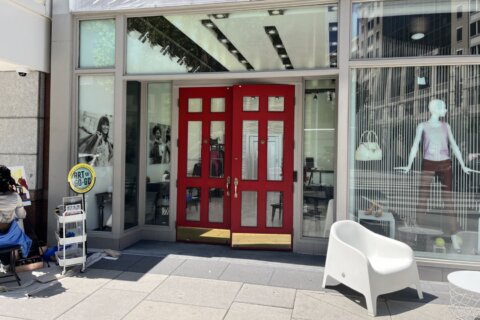WASHINGTON — Young black girls in D.C. are 30 times more likely to be arrested than white girls and boys of the same age, a new study shows.
Rights4Girls and the Georgetown Juvenile Justice Initiative noticed a concerning national trend: More girls today have had brushes with the juvenile justice system than girls in previous years, while the statistic for boys has dropped.
These girls are typically arrested for nonviolent offenses and misdemeanors that result in little to no injury — things such as truancy, running away, liquor law violations and disorderly conduct.
And while black girls are only 14 percent of the general population, 33 percent are detained and committed.
With this information, co-authors Yasmin Vafa and Eduardo Ferrer wondered about local trends.
“We knew from the conversations we were having with public defenders, with young girls themselves in D.C., that this was probably true of what was happening locally, and so we wanted to do this report. And what we found was, in many cases, the findings were even more staggering for young girls in D.C.,” Vafa, co-founder and executive director of Rights4Girls, said.
Statistics
In 2007, one in seven arrests of youth were girls. Since 2013, the trend has ticked upward: More than one in four are girls, according to the study. That’s an 87 percent increase.
Meanwhile, arrests for boys dropped 22 percent in the same period.
They’re also entering the system at younger ages than boys.
Between 2007 and 2015, arrests for 13-year-old and 15-year-old girls in D.C. more than doubled, and arrests for 14-year-old girls more than tripled.
Between 2007 and 2015, arrests of girls under 15 increased from half the arrests of young girls to 60 percent of the arrests of all young girls.
Within the black community, arrests of young black girls doubled, while arrests for young black boys only increased 6 percent (though they are still more likely to be arrested than their female counterparts).
Arrests for kids reported as white decreased in the same period.
The study didn’t break down arrest rates for other minorities in the D.C. area.
It should be noted that the population of females between the ages of 12 and 24 in the District are primarily girls and young women of color — 67 percent. Of that percentage, black girls make up 50.4 percent.
Conclusions
The study says that there is no evidence to suggest that girls are engaging in more criminal activity or becoming more violent. As a matter of fact, it says that 86 percent of the arrests of girls in D.C. are for nonviolent crimes.
Girls are more likely to be arrested for misdemeanors and “status offenses,” which are crimes that are only unlawful when committed by a minor, such as running away, truancy and curfew violations.
These offenses, as well as fighting at school or being the victims of sex trafficking, shed light on bigger issues regarding abuse and trauma, the study concludes.
“I think what you’re seeing driving girls into the system is an element of paternalism — that we have been used to young boys [ages] 12, 13 getting into fights and we can say, ‘Boys will be boys,'” said Ferrer, of the Georgetown Juvenile Justice Initiative. “When young women get into fights, there’s a tendency for the system to overcorrect and say, ‘Well, this isn’t ladylike behavior. This isn’t the type of behavior we want to see from young women and so the system needs to step in here.'”
And while D.C. recently stopped all arrests of minors engaged in prostitution — federal law states that minors in commercialized sex acts are the victims of human trafficking — victims are still coming into contact with the system for other offenses that are directly related to their exploitation.
“So we know that trafficking victims are being criminalized,” Vafa said.
Girls in D.C. are also experiencing homelessness at a disproportionate rate, and 20 percent of high school girls in the area report experiencing physical or sexual violence, the study found.
Though black girls make up more than half the population of girls in D.C., they’re more likely to live in poverty than their white counterparts, or be disconnected from education and employment opportunities, according to the study.
Twenty-six percent of black girls have also reported adverse childhood experiences (ACE) — such as abuse, family violence and parental separation — and 16 percent reported experiencing four or more ACEs.
Black girls are also six times more likely to be suspended from school, and they are more likely to be seen as hypersexual, defiant and treated older than they are. All the while, they are less likely to be seen as victims of violence and trauma, the study found.
The result?
“Our judicial system is stepping in, in many ways, in places where it’s really young girls who have been traumatized, who come from poor communities, who are young girls of color, who are trying to seek out help. And instead, we are criminalizing them,” Ferrer said.
Solutions
Juvenile delinquency practices are primarily based on boys, who are generally more likely than girls to be taken in for violent crimes. It is then assumed that these practices will be effective for girls. But they’re not, according to the study.
“This is a system that is largely designed for boys and largely for men. It’s not gender-responsive. It’s not trauma-informed,” Vafa said.
Since the vast majority of girls behind bars have suffered from abuse or violence, Vafa said, the practices only inflict more harm on young girls than inspire any kind of reform.
“Just thinking about the impacts of some of the really standard procedures that the juvenile justice system employs — things like the use of restraints …[and] the use of isolation and seclusion techniques — understanding that these are really traumatizing for any child, but … [especially] survivors of trauma, and oftentimes sexual violence, it’s really exacerbating,” she said.
Different tactics should be considered for young girls in the system, but Ferrer believes the real solution is to address the needs and the traumas of young girls before they come in contact with the system.
“What we want people [to really pay attention to] is the need to invest directly in our young girls of color in the city … so they can have the same type of opportunities that we want in all of our children,” said Ferrer.







